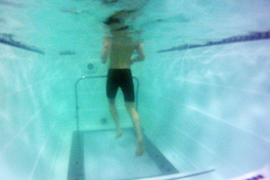
Research Quantifies Underwater Treadmill Energy Expenditure
Treadmills have a proven track record for assisting injured athlete rehabilitation, and water running or walking has long provided low-impact rehabilitation for people with injuries to lower extremities. University of Maine graduate and undergraduate students in exercise science have established in recent research that an underwater treadmill also can provide effective low-impact rehabilitation and cardiovascular conditioning.
Using 12 male Division 1 athletes from the UMaine hockey team, graduate students Philip Watson and Travis Bouchard and undergraduate Cassandra Mendonca, who received degrees in May 2012, along with Professor Robert Lehnhard, performed a series of metabolic tests on the athletes, comparing their performance for the first time on a traditional treadmill to the underwater treadmill. They collected data about the oxygen consumption, lactic acid buildup, heart rate and calories consumed during exercise with each exercise method.
“What was interesting was that, even for the manufacturer, there was no metabolic data quantifying how much exertion is involved with this piece of equipment,” Lehnhard says. “For example, nobody had ever determined the difference in metabolic impact from 2 miles per hour to 3 miles per hour.”
Among the concerns when rehabilitating an athlete with a joint injury has always been getting the athlete back to full strength without losing cardiovascular conditioning in the process, Lehnhard says. Lower limb injuries are a particular challenge.
“This piece of equipment fits nicely when impact is a concern,” Lehnhard says. “I think it fits well with rehab, but I don’t think it’s a tool you would use for (intense) conditioning.”
Lehnhard believes the underwater treadmill, in a pool with adjustable water jets and current, could also benefit non-athletes, since many people, particularly those just beginning an exercise program, are not conditioned for repeated impact on their joints.
A paper, “The metabolic response to treadmill graded exercise: traditional vs. underwater,” coauthored by Watson, Mendonca, Lehnhard and collaborating professors of education Shihfen Tu and Steve Butterfield, and Kenneth McKeever of the Rutgers Equine Science Center, has recently been published by the journal Comparative Exercise Physiology.
Contact: Robert Lehnhard, (207) 581-2480; George Manlove, (207) 581-3756
